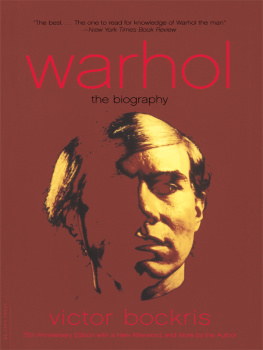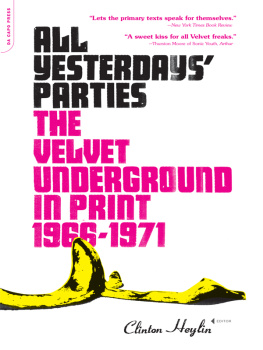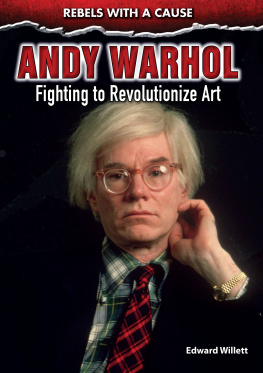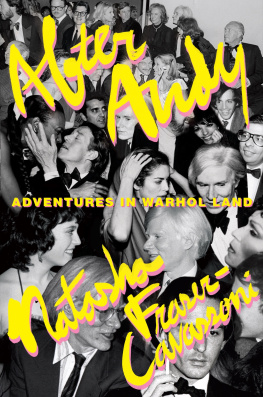Andy Warhol
Andy Warhol
Arthur C. Danto

Published with assistance from the Mary Cady tew Memorial Fund.
Copyright 2009 by Arthur Danto.
All rights reserved.
This book may not be reproduced, in whole or in part, including illustrations,
in any form (beyond that copying permitted by Sections 107 and 108 of the U.S.
Copyright Law and except by reviewers for the public press), without written
permission from the publishers.
Set in Janson type by Tseng Information Systems, Inc.
Printed in the United States of America.
Library of Congress Cataloging-in-Publication Data
Danto, Arthur Coleman, 1924
Andy Warhol / Arthur C. Danto.
p. cm. (Icons of America)
Includes bibliographical references and index.
ISBN 978-0-300-13555-8 (hardcover : alk. paper)
1. Warhol, Andy, 19281987Criticism and interpretation. 2. Art and
societyUnited StatesHistory20th century. I. Title.
N6537.W28D36 2009
700.92dc22 2009021638
A catalogue record for this book is available from the British Library.
This paper meets the requirements of ANSI/NISO Z39.48-1992
(Permanence of Paper).
10 9 8 7 6 5 4 3 2 1
Icons of America
Mark Crispin Miller, Series Editor
Icons of America is a series of short works written by leading scholars,
critics, and writers, each of whom tells a new and innovative story about
American history and culture through the lens of a single iconic individual,
event, object, or cultural phenomenon.
Alger Hiss and the Battle for History, by Susan Jacoby
Andy Warhol, by Arthur C. Danto
Frankly, My Dear: Gone with the Wind Revisited,
by Molly Haskell
Fred Astaire, by Joseph Epstein
Gypsy: The Art of the Tease, by Rachel Shteir
The Hamburger: A History, by Josh Ozersky
Inventing a Nation: Washington, Adams, Jefferson, by Gore Vidal
Kings Dream, by Eric J. Sundquist
Nearest Thing to Heaven: The Empire State Building and
American Dreams, by Mark Kingwell
Small Wonder: The Little Red Schoolhouse in History and Memory,
by Jonathan Zimmerman
Wall Street: Americas Dream Palace, by Steve Fraser
Forthcoming titles include:
Toni Bentley on George Balanchine
Stephen Cox on The Big House
Tom DeHaven on Superman
To Barack and Michelle Obama,
and the future of American art
Contents
Preface
There is no way in which I could write a new biography of Andy Warhol. My competence lies elsewhere. Fortunately, there are several quite good lives of Warhol that I could draw on, since my book is, roughly, chronological, and such writers as Victor Bockris, David Bourdon, and, more recently, Steven Watson have, collectively, constructed a fair narrative of Andys lifeof how he lived and how he diedand they had the benefit of knowing him and many of those around him. I have nothing to contribute to that. As a writer, I have published in philosophy primarily, including the philosophy of art; and secondarily as an art critic, chiefly in The Nation, a magazine of opinion which, beginning with Volume One, Number 1, on July 4, 1865, has always had an art critic. There is a connection between the two endeavors, and between them and this book. My philosophy of art was developed in two pieces of writingan article titled The Art World, published in the Journal of Philosophy in 1964, and, in 1981, a book, The Transfiguration of the Commonplace. Both of these were responses to developments in contemporary art that took place mainly in New York, in the 1960s, among them two exhibitions by Andy Warhol, held at the Stable Gallery, in 1962 and in 1964. The work in both these shows, but especially in the second show, necessitated, so it seemed to me, an entirely new approach to the philosophy of art, and I think that most aestheticians and philosophers of art would agree that the writings just mentioned must be given substantial credit for redirecting the philosophy of art to take account of the immense artistic revolution that took place in the early to mid-1960s, in which, as an artist, Andy Warhol played a prominent role. But the art through which Warhol achieved historical importance was internally connected with his candidacy as an American icon. He was able to achieve iconic status because of the content of his art, which drew directly from, and which indeed celebrated, the form of life lived by Americans, including what Americans ate, and who Americans considered icons in their own right, mainly figures from mass culture, like movies and popular music.
In a way, Warhol transcended his chosen subjects in the eyes of the world. His art was typically interpreted by European intellectuals as critical both of American mass culture and of the products of American capitalism, like Campbells soup. Seen as a critic of American culture, Warholand the Pop artists generallywere given considerable credit by Europeans, and were taken seriously by them as artists in a way that they were not, at first at least, by the American art world, which had finally begun to accept the fact that America had, for the first time in history, produced world class art through the paintings of the so-called New York schoolthe great Abstract Expressionist canvases produced during and after World War II. In American art circles, it came as a shock that the Pop artists should repudiate this immense aesthetic achievement, and paint what looked like simpleminded pictures of soup cans or Donald Duck. It was widely felt that important painting had to be difficultbut anyone in the culture could get what Pop art showed immediately. Whether the Europeans were right or not, that Pop art was critical of American culture, they at least felt that there was more to the new art than met the eye. Andy, at least, seemed eager to present himself to the European art world as anything but frivolous. He and his dealer, Ileana Sonnabend, were at odds over how his first show at her gallery in Paris should be presented. He wanted to call it Death in America, and to consist of paintings of car crashes, race riots, and electric chairs, and be based on silk-screen images of tabloid newspaper photographs, but often in candy colors. In the end Sonnabend accepted the content, but not the title. It was simply called Warhol. It was certainly a serious show, which the Europeans respected. He could not have had that show in America at that pointJanuary 1964.
The European art world in the twentieth century was necessarily more complicated than the American art world, because more was at stake. Art in Europe was heavily politicized. Abstract art, for example, under both Hitler and Stalin, was politically unacceptable. It remained unacceptable in Soviet Russia throughout the Cold War. German artists, on the other hand, came to feel, after World War II, that abstraction expressed the political values of democracy. And since under Hitler, a certain kind of kitschy realism was felt to express the values of National Socialism, figural art became politically suspect after the war. So by the 1960s, when Pop art seemed to question the values of Abstract Expressionism, it seemed a particularly liberating moment. Pop seemed politically important in Germany because it seemed to repudiate abstraction. This increased Warhols stature on the Continent. He was seen not only as a critic of capitalist production, but as a critic of American high culture as well. When the first serious monograph on Warhol, by Rainer Crone, was published in Germany, it became a best seller. It took a long time for Warhol to become intellectually respectable in America. Instead, he became an icon. He became part of the culture he celebrateda star who loved hotdogs and Coca-Cola, and worshipped Marilyn and Elvis.
Next page





